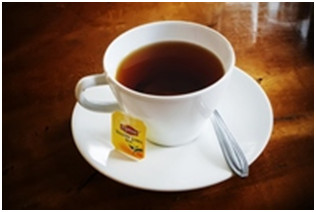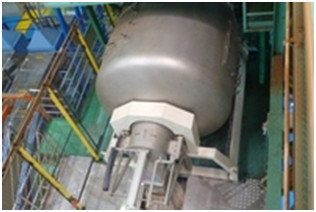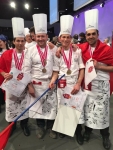
The world’s largest and probably most renowned tea brand, Lipton Tea, has been using Lindor mixers for blending tea for over a decade. Lipton uses Lindor mixers to blend tea worldwide in their tea plants and R&D centres. The fragile tea leaves are carefully handled by the gentle touch Lindor mixers. Within a mere three minutes the various teas and possibly other ingredients are homogeneously mixed to make the final blend, ready for packing. Most Lindor mixers are equipped with liquid injection for flavouring.
Blending tea
Tea of different origins is being blended and packed for distribution to retail in tea plants around the world. The blending takes place at the beginning of the process, right after the tea received from the plantation is taken out of the bags, screened and prepared for a batch. The various teas and possibly other ingredients (such as h erbs, flower petals or fruit pieces) are tipped into the mixer in which a homogeneous blend is made without losing the integrity of the individual components. Tea leaves can have many different characteristics: from very small broken tea leaves, more like a powder, to long leaves up to up to 2 – 3 cm (1’’), more like brittle pine needles.
erbs, flower petals or fruit pieces) are tipped into the mixer in which a homogeneous blend is made without losing the integrity of the individual components. Tea leaves can have many different characteristics: from very small broken tea leaves, more like a powder, to long leaves up to up to 2 – 3 cm (1’’), more like brittle pine needles.
After the blending the tea is ready for packaging in tea bags or as loose tea in a pack, box or tin.
Lindor and Lipton
Bastiaan Soeteman, Managing Director of Lindor in Dordrecht (the Netherlands), is proud of Lindor’s long relationship with Lipton: “We have delivered in 2003 our first mixer to their plant in Brussels. Since then, we have been fortunate to design and manufacture many more mixers for their tea packing plants and R&D centres around the world. The last mixer, an L4000 (type number indicating a net batch volume of 4000 litres), was delivered to Indonesia in July of last year. By exception it was even airlifted to meet a tight installation schedule!”
There are two main reasons for Lipton to choose the Lindor mixer. First of all the mixers produce a constant, homogeneous blend within a short cycle time. Secondly, the precious tea does not get damaged during the blending process, thus ensuring a superior product quality.
A global technology manager for Lipton explains: “Good blending of the various tea types and ingredients is crucial to us to offer our consumers always the same good taste and colour experience when they drink a cup of Lipton tea. Also, the tea leaves cannot be damaged. In the Lindor this is really kept to an absolute minimum.
Lipton values their relationship with Lindor, as he explains: “We are very pleased with the excellent collaboration and Lindor’s flexibility in meeting even tight delivery schedules. The Lindor people know exactly what we need. The project in Indonesia is a good example. The available time for installing the new machine was really short. In case of a delay we could run out of stocks and we risk supply interruptions to the market. Together with our team in Indonesia the Lindor team has taken this challenge on and completed well within time.”
Lindor mixer for tea
The Lindor mixer has a rotating drum with 3 or 6 fixed blades.  The geometry of these blades and their relative position in the drum cause the actual mixing trajectory of the products and cause the drum to discharge all the product through the outlet after opening the outlet valve. The mixer discharges completely, typically better than 99.9%.
The geometry of these blades and their relative position in the drum cause the actual mixing trajectory of the products and cause the drum to discharge all the product through the outlet after opening the outlet valve. The mixer discharges completely, typically better than 99.9%.
The mixer can blend batches of500, 1000 … 4000 litres, which would produce 150, 300 … 1200 kg respectively at a bulk density of 0.3g/cc. The largest tea mixer ever delivered by Lindor was an L12000 with a batch volume of 12 m3. Per batch this mixer can blend an equivalent of about 1.8 million tea bags, or within 5 batches provide everyone in London with a cup of tea!
There are also mixers designed for small batches. These are used for small or start up tea companies, pilot plants and R&D centres. Their batch sizes vary from 10 to 200 litres.
Most mixers are equipped with a liquid injection system to be able to flavour the tea, such as bergamot oil to make Earl Grey tea. Adding dry flavour compounds is also an option , or sometimes both are done at the same time to provide more flavour and a more intense fragrance. Within a few minutes all ingredients are combined to a beautiful homogeneous blend.
The Lindor machines comply with the latest safety and hygiene requirements (CE, DIN, FDA).
Three large inspection doors in the drum provide access for inspection and dry or wet cleaning. Metal contact parts are made of AISI 304 or 316 stainless steel. Other features are retractable inlet and outlet to provide even more access for inspection and cleaning and for cleaning or replacing seals, for instance if recipes with allergenic ingredients are processed.
A full CIP (Cleaning In Place) installation can be integrated, with or without hot air drying, for (semi) automatic wet cleaning.
Lipton Tea
Lipton Tea was founded by Sir Thomas Lipton (1848 – 1931). His vision was to make good quality tea accessible to a large market, whereas before then it was an expensive product only available to the more wealthy people. In 1890 he set sail to Ceylon (now Sri Lanka) to purchase land and start his own tea plantations. He restructured the traditional way of working and became more efficient. He also set up his own stores in the UK and USA for selling the tea directly to the general public. His more efficient supply chain, lower prices and the strong Lipton brand he had created led to the largest tea brand in the world. Due to Lipton tea has become an affordable drink for everyone. Lipton is now part of Unilever.




